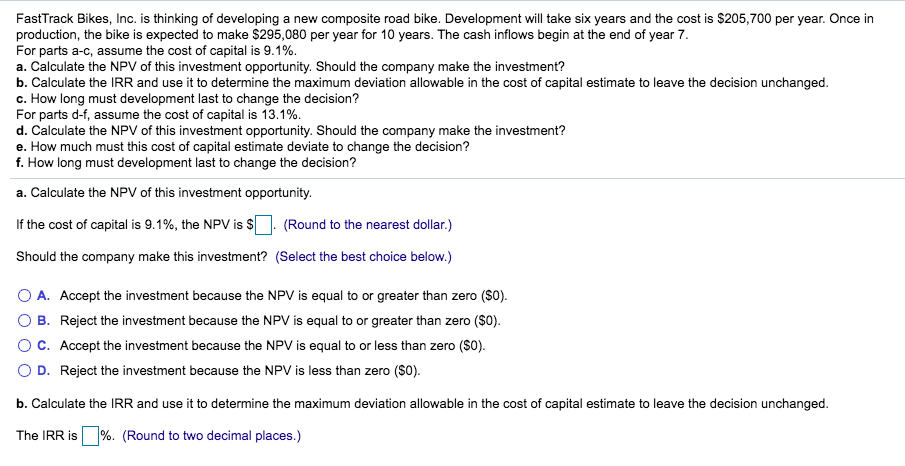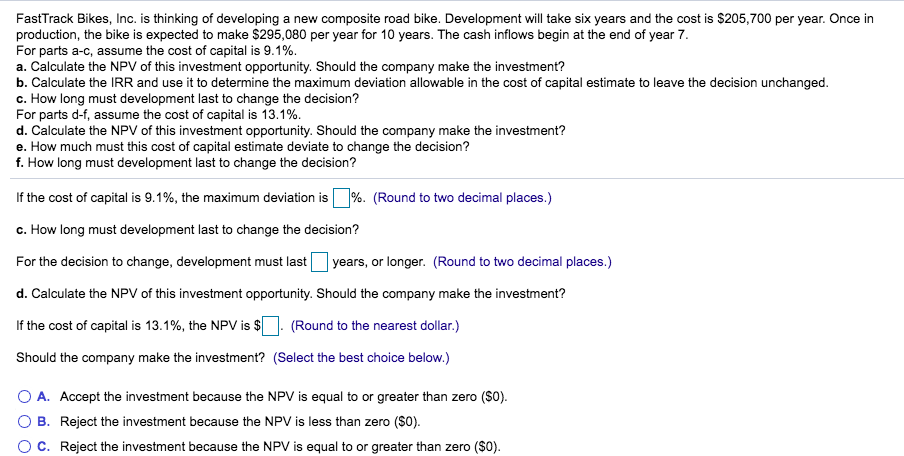


FastTrack Bikes, Inc. is thinking of developing a new composite road bike. Development will take six years and the cost is $205,700 per year. Once in production, the bike is expected to make $295,080 per year for 10 years. The cash inflows begin at the end of year 7. For parts a-c, assume the cost of capital is 9.1%. a. Calculate the NPV of this investment opportunity. Should the company make the investment? b. Calculate the IRR and use it to determine the maximum deviation allowable in the cost of capital estimate to leave the decision unchanged. c. How long must development last to change the decision? For parts d-f, assume the cost of capital is 13.1%. d. Calculate the NPV of this investment opportunity. Should the company make the investment? e. How much must this cost of capital estimate deviate to change the decision? f. How long must development last to change the decision? a. Calculate the NPV of this investment opportunity. If the cost of capital is 9.1%, the NPV is $ . (Round to the nearest dollar.) Should the company make this investment? (Select the best choice below.) O A. Accept the investment because the NPV is equal to or greater than zero ($0). OB. Reject the investment because the NPV is equal to or greater than zero ($0). OC. Accept the investment because the NPV is equal to or less than zero ($0). OD. Reject the investment because the NPV is less than zero (SO). b. Calculate the IRR and use it to determine the maximum deviation allowable in the cost of capital estimate to leave the decision unchanged. The IRR is %. (Round to two decimal places.) FastTrack Bikes, Inc. is thinking of developing a new composite road bike. Development will take six years and the cost is $205,700 per year. Once in production, the bike is expected to make $295,080 per year for 10 years. The cash inflows begin at the end of year 7. For parts a-c, assume the cost of capital is 9.1%. a. Calculate the NPV of this investment opportunity. Should the company make the investment? b. Calculate the IRR and use it to determine the maximum deviation allowable in the cost of capital estimate to leave the decision unchanged. c. How long must development last to change the decision? For parts d-f, assume the cost of capital is 13.1%. d. Calculate the NPV of this investment opportunity. Should the company make the investment? e. How much must this cost of capital estimate deviate to change the decision? f. How long must development last to change the decision? If the cost of capital is 9.1%, the maximum deviation is % (Round to two decimal places.) c. How long must development last to change the decision? For the decision to change, development must last years, or longer. (Round to two decimal places.) d. Calculate the NPV of this investment opportunity. Should the company make the investment? If the cost of capital is 13.1%, the NPV is $ . (Round to the nearest dollar.) Should the company make the investment? (Select the best choice below.) O A. Accept the investment because the NPV is equal to or greater than zero ($0). OB. Reject the investment because the NPV is less than zero (SO). O C. Reject the investment because the NPV is equal to or greater than zero ($0). OD. Accept the investment because the NPV is equal to or less than zero (SO). e. How much must this cost of capital estimate deviate to change the decision? The maximum deviation is %. (Round to two decimal places.) f. How long must development last to change the decision? For the decision to change, development must last no longer than years. (Round to two decimal places.) FastTrack Bikes, Inc. is thinking of developing a new composite road bike. Development will take six years and the cost is $205,700 per year. Once in production, the bike is expected to make $295,080 per year for 10 years. The cash inflows begin at the end of year 7. For parts a-c, assume the cost of capital is 9.1%. a. Calculate the NPV of this investment opportunity. Should the company make the investment? b. Calculate the IRR and use it to determine the maximum deviation allowable in the cost of capital estimate to leave the decision unchanged. c. How long must development last to change the decision? For parts d-f, assume the cost of capital is 13.1%. d. Calculate the NPV of this investment opportunity. Should the company make the investment? e. How much must this cost of capital estimate deviate to change the decision? f. How long must development last to change the decision? a. Calculate the NPV of this investment opportunity. If the cost of capital is 9.1%, the NPV is $ . (Round to the nearest dollar.) Should the company make this investment? (Select the best choice below.) O A. Accept the investment because the NPV is equal to or greater than zero ($0). OB. Reject the investment because the NPV is equal to or greater than zero ($0). OC. Accept the investment because the NPV is equal to or less than zero ($0). OD. Reject the investment because the NPV is less than zero (SO). b. Calculate the IRR and use it to determine the maximum deviation allowable in the cost of capital estimate to leave the decision unchanged. The IRR is %. (Round to two decimal places.) FastTrack Bikes, Inc. is thinking of developing a new composite road bike. Development will take six years and the cost is $205,700 per year. Once in production, the bike is expected to make $295,080 per year for 10 years. The cash inflows begin at the end of year 7. For parts a-c, assume the cost of capital is 9.1%. a. Calculate the NPV of this investment opportunity. Should the company make the investment? b. Calculate the IRR and use it to determine the maximum deviation allowable in the cost of capital estimate to leave the decision unchanged. c. How long must development last to change the decision? For parts d-f, assume the cost of capital is 13.1%. d. Calculate the NPV of this investment opportunity. Should the company make the investment? e. How much must this cost of capital estimate deviate to change the decision? f. How long must development last to change the decision? If the cost of capital is 9.1%, the maximum deviation is % (Round to two decimal places.) c. How long must development last to change the decision? For the decision to change, development must last years, or longer. (Round to two decimal places.) d. Calculate the NPV of this investment opportunity. Should the company make the investment? If the cost of capital is 13.1%, the NPV is $ . (Round to the nearest dollar.) Should the company make the investment? (Select the best choice below.) O A. Accept the investment because the NPV is equal to or greater than zero ($0). OB. Reject the investment because the NPV is less than zero (SO). O C. Reject the investment because the NPV is equal to or greater than zero ($0). OD. Accept the investment because the NPV is equal to or less than zero (SO). e. How much must this cost of capital estimate deviate to change the decision? The maximum deviation is %. (Round to two decimal places.) f. How long must development last to change the decision? For the decision to change, development must last no longer than years. (Round to two decimal places.)









